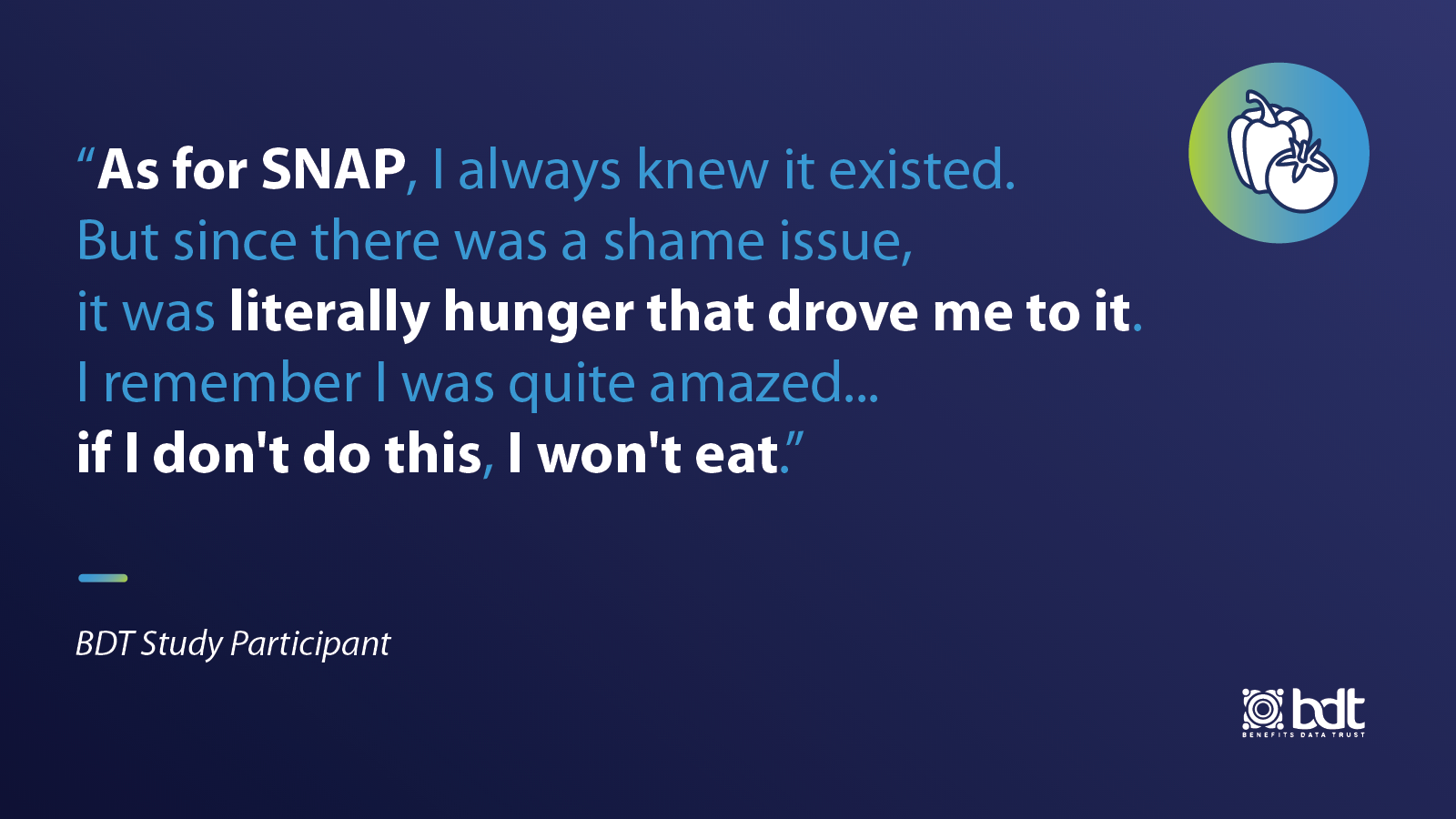
For over 40 million people nationwide,[1] the Supplemental Nutrition Assistance Program (SNAP) is a vital resource to help put food on the table. Yet, so many more are missing out on this assistance that can build financial security and improve health, due to the stigma of accessing benefits, along with a number of other systemic barriers. For older adults, SNAP is even more crucial to overall wellbeing — higher SNAP enrollment for older adults is associated with fewer hospital and long-term care admissions as well as emergency room visits.[2] However, 52% of eligible adults ages 60 and over nationwide are not enrolled in SNAP.[3]
Benefits Data Trust (BDT) is a national nonprofit committed to streamlining public benefits systems and connecting eligible people to programs that help pay for food, healthcare, housing, and more. BDT is committed to finding ways to overcome the most common barriers to benefits access — such as cumbersome applications, under-resourced staff, underutilized technology, scheduling and mobility issues, language barriers, and misinformation — to better serve populations and create more dignified experiences for those in need. Another key part of our work is to understand specific populations and the nuances of those common barriers as time and technology change, in order to tailor our services and, ultimately, share our findings.
Reaching Older Adults in Rural Colorado
In 2019, BDT studied whether older adults (ages 50 and over) in urban and suburban Colorado would engage with our SMS texting campaigns, which notify households of likely benefit eligibility and the opportunity to use BDT’s online self-screening tool. The tool, Benefits Launch Express (BLX), allows individuals to check if they are likely eligible for benefits and find the path of service that best fits their needs. Based on our findings, BDT refined BLX to improve user experience and outcomes.
Building off of those findings, and with generous support from NextFifty Initiative, BDT’s research team set out to understand the needs of older adults in rural and frontier areas in Colorado and how both BDT and community-based organizations (CBOs) can support them in applying for critical benefits.
This research provides BDT the opportunity to shape our tools and approaches to create innovative pathways to benefits for older adults in rural and frontier communities nationwide and provide thoughtful advice to CBOs and agencies that serve similar populations — in turn, allowing us to modernize and humanize benefits systems.
Here’s how we approached our study:
Research Methods and Participants
- Conducted in-depth interviews — via phone and video chat — with 25 older adults and 11 CBO staff members in rural and frontier communities in Colorado
- Sent an online survey to 43 CBO staff members serving communities across the state of Colorado
- Reviewed the 2021 analytics from BLX
Through these methods, we were able to collect key findings about the challenges and opportunities at an individual and organizational level, including how technology, communication, messaging, and information play a vital role in benefit access for rural and frontier communities.
Identifying the Barriers: Challenges and Opportunities
Through our research, we confirmed that barriers to benefits access come in all shapes and sizes and often exist due to stigma and inefficiencies of current benefits systems. For example, we found that many older adults in rural and frontier communities were not aware of benefits that were available to them. Beyond that, there were significant cultural and physical barriers that kept these communities from accessing vital assistance programs. Cultural barriers — including negative views and implications about government programs and those who enroll in them, pride, and distrust of the federal and state government — are very much an issue for this population. Many individuals who we spoke to expressed those feelings.
Physical barriers include lack of access to technology, lack of access to transportation, and the overall complexity of the application process. Additionally, low digital literacy creates a significant behavioral barrier. For many of the study participants, these barriers were present in their decision to seek assistance, or not. These findings are consistent with our previous knowledge of what physical and cultural aspects often inhibit individuals from enrolling in critical programs.
It’s important to note that older adults rarely apply for benefits on their own — most rely on help from loved ones, CBOs, or social workers. CBO staff in rural Colorado provide support, resources, and navigation through complex assistance systems, and often maintain relationships with clients over the long term. As part of a larger support network — including county departments, other nonprofits, healthcare providers, school districts, and libraries — collaboration and sharing information among these partners is key to serving clients at a high level. Unfortunately, the biggest organizational challenges that CBOs face are limited capacity and lack of staff expertise.
These challenges are difficult, but as an organization that dedicates its efforts to make benefits access equitable and streamlined, we have recommendations on how to mitigate their presence for both the individuals applying for benefits and the staff that can assist them.
How We Can Change Systems for the Better: Lessons Learned and Recommendations
Through our research, it became clear that implementing changes at an individual and organizational level would greatly improve the experience of accessing assistance for older adults in rural and frontier communities. Although older adults are not a monolithic group and differ in terms of communication preferences and technology access barriers, this study reinforced our prior understanding of three key areas of improvement: raise awareness, reduce stigma, and build trust to reduce cultural barriers; tackle physical and technology barriers to increase access; and expand avenues to access and equip CBOs with the proper resources.
Raise awareness, reduce stigma, and build trust to overcome cultural barriers
-
Messaging around benefits should focus on educating the public that by applying for benefits like SNAP, you are not taking assistance away from others who need it more.
-
Messaging around benefits, especially outreach, needs to be carefully crafted to help overcome the stigma, such as circulating narratives that normalize seeking out benefits:
- Avoid messaging that discusses the “myths” and “realities” around benefits, as these focus people on benefits stigma.
- Provide stories of ordinary, hard-working people getting benefits to further shift the narrative away from the stereotypes that suggest accessing benefits is due to laziness or “milking the system”.
- Use language that frames benefits as programs that “you paid into or paid taxes towards over your lifetime” and not “help”.
-
Agencies and CBOs need to make one-on-one help available for older adults — this is especially needed to communicate with county offices or state agencies once an application has been submitted, as many older adults prefer to have one point of contact throughout the process to build trust.
-
Building trusted relationships between individuals and local partners is key. These partners can include churches, food banks, senior centers, schools, etc.
- CBO staff members can attend community events often to build relationships with individuals and increase local trust over time.
- When sharing benefit information, branding from known, local organizations should be used to increase trust.
-
Agencies can leverage benefits champions — people in the community who have experience with benefits and who talk about benefits with others — to raise awareness and share pertinent information about benefit access with older adults.
Tackle physical and technological barriers
-
As transportation can cause issues for individuals in geographically dispersed rural and frontier communities, staff should meet people where they are (and where they feel comfortable) when discussing benefit awareness and education, as well as for screening and application help. Key local sites include:
- Churches
- Food banks
- Doctors' offices or hospitals
- Senior centers
- Grocery stores
-
In-person connections — when safely available, given the COVID-19 pandemic — for benefits screening and application are preferred over other channels by both CBOs and older individuals applying for benefits, so in-person help should be prioritized if the resources are available.
-
Benefits materials should have a range of accessibility — for instance, being available in larger font for printed material and with captions for audio material — and should be available in multiple languages, especially in Spanish.
-
Assistance should be available outside of 9 to 5 working hours so that potential beneficiaries can access help without having to take time off work.
Expand avenues to access and equip CBOs with the proper resources
-
CBOs should be provided with a range of tools to choose from to provide benefits assistance — including quick eligibility screeners, full application tools, and referral systems — as different agencies can provide different levels of service based on the time and staff they have available.
-
Additional staff and more training around benefits are two major resources that CBOs need to serve more people and communities in need.
- BDT can partner with CBOs to facilitate calls between clients and the Colorado Benefits Center — operated by BDT — to alleviate the need to train CBO staff and still allow clients to apply for benefits with a trusted person present.
BDT is committed to bridging the gap between available assistance and those in need, both through studying ways to improve access and implementing those recommendations alongside key community partners. Through tools like BLX, our texting outreach campaigns, and our contact centers — currently offering one-on-one application assistance over the phone for residents in seven states, including Colorado — we’re able to provide solutions in all shapes and sizes for communities with differing needs.
By studying specific communities, we’re able to better understand the barriers to access, how they overlap with other demographics, and uncover how to improve the ways in which individuals interact with and access vital resources. This new research allows us to further our understanding of ways to best reach and engage with specific communities in Colorado — BDT’s previous research helped to prove the value of tailoring messages and methods to substantially increase outreach response rates.
Not only can we better equip ourselves through continued research, but we can also equip CBOs and local agencies, empowering them to better meet the needs of their communities. Together, our efforts can help families put food on the table and reduce the stigma around accessing public benefits to help build equity and improve health nationwide.
To learn more about our research efforts, reach out to us at ux-research@bdtrust.org.
BDT would like to thank Hunger Free Colorado for their help in connecting us to community-based organizations in Colorado and NextFifty Initiative for their gracious support in conducting this study.
